Small Garden Design: 10 Tips to Maximize Limited Space
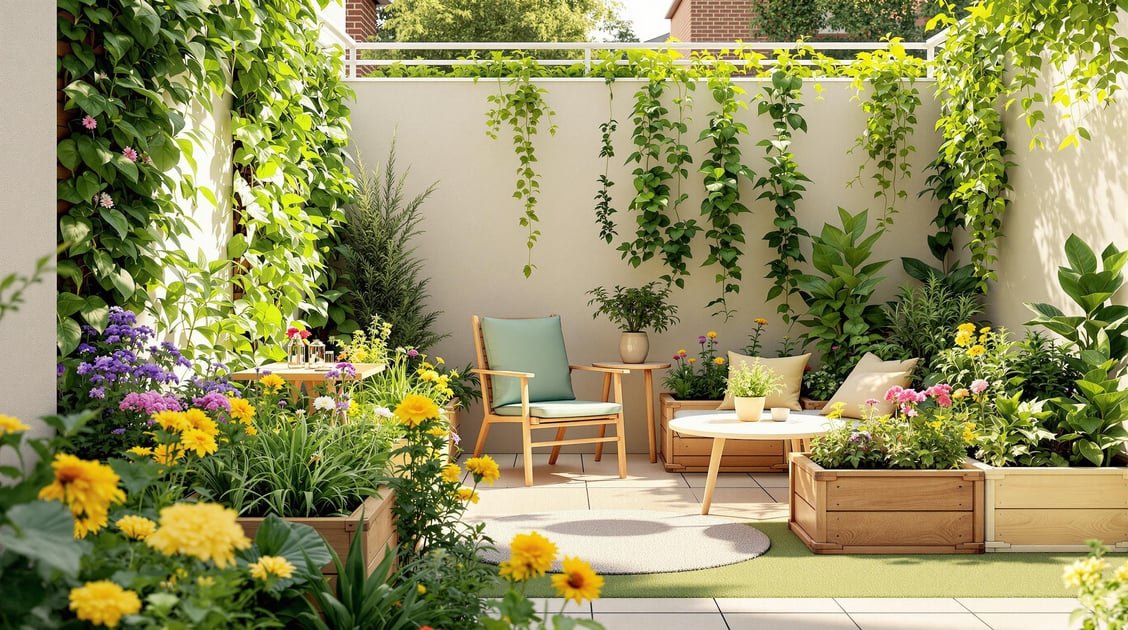
Want to make the most of your small garden? Here’s how you can create a functional, beautiful outdoor space, even with limited room. From vertical gardening to space-saving furniture, these tips will help you maximize every inch.
Key Takeaways:
- Go Vertical: Use wall planters, trellises, or living walls to save ground space.
- Smart Furniture: Pick multi-purpose, foldable, or stackable furniture.
- Container Gardening: Grow plants in pots for flexibility and easy management.
- Divide Your Space: Create zones for dining, relaxing, or gardening.
- Compact Plants: Choose small or dwarf varieties for high yield in tight spaces.
- Light & Reflection: Use mirrors, light-colored surfaces, and strategic plant placement to brighten the area.
- Water Features: Add small, calming water elements like mini ponds or wall fountains.
- Simple Design: Keep layouts clean, colors minimal, and clutter under control.
- Tool Organization: Use vertical storage or dual-purpose benches to save space.
Pro Tip: Start by assessing your garden’s layout and sunlight. Prioritize features based on your needs - whether it’s privacy, seating, or greenery. With these strategies, even the smallest garden can feel spacious and inviting.
8 Small Garden Design Tips for Maximizing Tiny Spaces

1. Install Vertical Gardens and Wall Planters
Vertical gardening transforms unused wall space into a productive growing area, making it possible to expand your garden without taking up valuable ground space. It’s a smart way to maximize your planting potential while experimenting with creative setups.
Start by selecting a vertical system that suits your space. Options include wall-mounted planters, trellises, or living walls. Look for a vertical garden kit that matches your available area and can handle the plants you want to grow.
"Vertical gardening saves on water usage because water dripping from the top layer will also water plants below." – Carrie Spoonemore, Co-creator of Park Seed's From Seed to Spoon app
Here are some plant suggestions that work well in vertical gardens:
| Plant Type | Examples |
|---|---|
| Flowering | Petunias, Verbena, Sweet alyssum |
| Edibles | Cherry tomatoes, Scarlet Runner Beans |
| Foliage | Boston fern, English ivy, Pothos |
| Herbs | Chives, Oregano |
Steps for a Successful Setup
- Check wall and mounting system strength: Ensure they can handle the weight of soil, plants, and water.
- Install a watering system: A watering wand or drip irrigation ensures plants get consistent moisture.
- Group plants with similar needs: This simplifies care and helps plants thrive.
- Use pot feet or wheeled stands: These make it easier to rotate plants for even sunlight exposure.
If you’re into DIY projects, consider repurposing items like shoe organizers, pallets, or rain gutters for vertical planters.
Use high-quality potting soil enriched with slow-release fertilizers, particularly those high in phosphorus and potassium for growing vegetables. For climbing plants, check the labels to differentiate between vining and bush varieties. For added visual appeal, try cascading plants like Wave petunias or creeping phlox.
2. Select Space-Saving Garden Furniture
Once you've utilized vertical space, the right furniture can make your garden even more functional and inviting.
Choosing the right furniture can transform a small garden into a versatile outdoor area. The trick is to pick items that serve more than one purpose while keeping the space tidy and open.
Multi-Purpose Furniture
Look for furniture that does double duty. For example, storage benches can hold gardening tools or cushions while also providing seating. Corner sofas are perfect for making the most of those overlooked corner spots.
| Furniture Type | Space-Saving Features | Ideal Uses |
|---|---|---|
| Cube Sets | Compact nesting design | Dining and casual seating |
| Corner Sofas | Fits into unused corners | Lounging and entertaining |
| Storage Benches | Built-in storage compartments | Seating and organization |
| Folding Chairs | Easy to store and move | Flexible seating options |
Choose the Right Materials
Durability and low maintenance are key. Aluminum furniture is lightweight, rust-resistant, and requires very little upkeep. Synthetic wicker and HDPE plastic are also great choices - they stand up to the weather and keep their good looks over time.
Tips for Saving Space
- Opt for lightweight furniture you can easily move around.
- Use foldable or stackable pieces to save room when not in use.
- Go for designs that look visually light, like those with open frames.
- Think about suspended furniture, such as hanging chairs, to free up floor space.
"IKEA's SUNDSÖ folding chair, available for $24, offers compact, storable seating." – IKEA.com, 2024
For even more flexibility, try extendable tables. They’re perfect for accommodating guests when needed but take up less space during everyday use.
Pairing smart furniture choices with vertical design strategies ensures you make the most of every inch of your garden. Select pieces that not only fit your space but also enhance its style and functionality.
🚀 Ready to Reinvent Your Garden?
Join thousands of homeowners who have transformed their gardens using our AI design tool. Upload one photo to explore endless possibilities.
Get your AI garden designs →3. Use Containers for Easy Plant Management
Container gardening is a practical way to grow plants in small spaces while maintaining control over their environment. Much like vertical gardens or compact furniture, it makes the most of limited areas with smart planning.
Choosing the Right Containers
When selecting containers, focus on these essentials:
- Drainage holes to prevent waterlogging
- Appropriate size to support mature plants
- Durable materials suited for outdoor use
Here’s a quick guide to popular container types:
| Container Type | Best For | Benefits |
|---|---|---|
| Deep Pots | Root vegetables, tomatoes | Retains water well and maintains temperature |
| Window Boxes | Herbs, shallow-rooted plants | Saves space and provides easy access |
| Hanging Baskets | Trailing flowers, small veggies | Makes use of overhead space; adds charm |
| Self-Watering Containers | Moisture-loving plants | Keeps soil evenly moist with less effort |
Soil and Care Essentials
For container plants, use a high-quality, sterilized soilless potting mix. This ensures proper drainage, aeration, and healthier roots.
Keep these maintenance tips in mind:
- Watering: During hot weather, water daily, or even twice a day if needed.
- Fertilizing: Use slow-release pellets or water-soluble fertilizers every 1–2 weeks.
- Rotation: Turn containers regularly for even sunlight exposure.
- Moisture Check: Test soil by inserting your finger about an inch deep to ensure proper hydration.
These simple steps help keep your container plants thriving.
Placement for Maximum Impact
Strategically placing containers can transform your space. Their mobility allows for easy rearrangement, letting you experiment with different layouts. Try grouping containers in triangular clusters to create visual interest.
Container gardening also saves time and energy compared to traditional in-ground planting. It offers the flexibility to control growing conditions and adapt to your needs.
Picking the Right Plants
Choose plants that grow well in containers and match your local climate. Combine species with similar water and sunlight needs in the same pot. For a striking effect, pair fine-textured foliage plants with plain walls for contrast.
If space is tight, focus on these options:
- Compact vegetables
- Culinary herbs
- Dwarf fruit trees
- Flowers for continuous color
- Vertical-growing plants that can climb or be trained upward
With the right choices, even the smallest space can become a thriving garden.
4. Divide Space into Purpose-Built Areas
After incorporating space-saving ideas like vertical gardening and container planting, take it a step further by dividing your garden into specific zones. This approach gives your outdoor space more functionality and a clear structure.
Strategic Zone Planning
Think of your garden as a series of connected "rooms", each with its own purpose. For instance, place a dining area close to your kitchen for convenience, or set up a cozy reading nook in a shaded spot.
Here are some ways to define these zones:
| Divider Type | Best Uses | Maintenance Level |
|---|---|---|
| Low Hedges | Creates subtle boundaries, formal look | Medium – regular trimming |
| Potted Plants | Flexible, easy to rearrange | Low – routine watering |
| Screens/Trellis | Adds privacy and vertical planting space | Low – occasional cleaning |
| Stepping Stones | Defines paths and transitions | Minimal |
| Pergolas | Provides shade and visual interest | Medium – yearly inspection |
Creative Division Techniques
Soft boundaries can divide spaces without making them feel closed off. Alma Hecht, a designer in San Francisco, transformed a backyard into distinct areas for living, dining, and gardening. She achieved this while keeping the space visually open by carefully placing plants.
Here are some ideas to create divisions:
- Use different flooring materials to naturally separate zones.
- Add laser-cut screens for a modern touch.
- Grow climbing plants on trellises to form living walls.
- Place large container plants as movable dividers.
- Use outdoor art or sculptures to act as functional boundaries.
Maximizing Visual Space
Clear sight lines can make your garden feel larger and more open. Here’s how:
- Use plants of varying heights to create depth.
- Add lighting to highlight zones after sunset.
- Install wall cladding to bring in texture and divide areas vertically.
- Experiment with multi-level zones using raised beds or sunken seating areas.
- Paint accent walls in complementary colors to define sections.
5. Plant Small-Growing Plant Varieties
Choosing compact plant varieties is a smart way to make the most of limited garden space. These smaller plants are perfect for creating a productive and attractive garden without overcrowding.
Dwarf Vegetables That Deliver Big Harvests
Thanks to modern plant breeding, there are now small-sized plants that produce impressive yields. For instance, the 'Baby Boomer' cherry tomato can produce up to 300 one-ounce tomatoes per bush while maintaining a tidy, compact shape.
| Plant Type | Recommended Variety | Size | Days to Harvest |
|---|---|---|---|
| Cherry Tomato | 'Baby Boomer' | Compact bush form | |
| Lettuce | 'Little Gem' | 4-inch head | 35 days |
| Eggplant | 'Patio Baby' | 18–24 inches tall | |
| Cucumber | 'Spacemaster' | 7–8 inch fruit | |
| Peas | 'Tom Thumb' | 10 inches tall |
Tips for Picking the Right Plants
When planning your small garden, keep these points in mind:
- Look for varieties labeled "bush" or "dwarf", as they are designed for smaller spaces.
- Choose plants that provide year-round interest with their foliage, flowers, or structure.
- Make sure the plants you select are suitable for your garden's light conditions and USDA hardiness zone.
"Dwarf vegetables and fruit provide hefty harvests from small pots and small plots or patios!" – Doreen G. Howard, Author
Make the Most of Your Space
To get the best results in a small garden, focus on plants that offer extended harvests. For example, cut-and-come-again crops like leaf lettuce allow for multiple harvests from one planting. The 'Micro Tom' tomato, the world's smallest tomato plant, grows just 6–8 inches tall but still produces full-sized cherry tomatoes.
Don't forget to think vertically. Even compact plants can benefit from growing upward. While small-rooted vegetables like 'Thumbelina' carrots thrive in containers, vining plants like 'Spacemaster' cucumbers can be trained on trellises to save space on the ground.
sbb-itb-4d6a8dd
6. Improve Light Distribution
Make the most of natural light in small gardens with reflective surfaces and thoughtful design. These techniques work well alongside other strategies to maximize your garden's potential.
Reflective Surfaces
Use light-colored paint on walls and structures to bounce sunlight around your garden. Focus on south-facing surfaces like garden walls, shed exteriors, pergolas, and rose arches to spread light effectively.
Smart Material Choices
Incorporate materials that brighten your space. Here are some ideas:
| Element | Purpose | Best Placement |
|---|---|---|
| Mirrors | Reflect light into darker areas | Brightest garden section |
| Water Features | Create dynamic light reflections | Central viewing areas |
| Glass Sculptures | Scatter light in creative patterns | Sunlit spots |
| White River Rocks | Reflect light at ground level | Around plant bases |
Canopy Management
Prune tree crowns carefully to let more light through while maintaining their natural shape.
Strategic Plant Selection
Pair reflective surfaces with plants that brighten your garden. Use white flowers in shady spots, variegated foliage to lighten dark corners, and elevate planters to catch more light.
"Plant up high and use mirrors to create light and depth" – PlantPlots
Vertical Elements
Introduce vertical features to enhance light flow and create a sense of depth. Add reflective accents strategically to open up the space without causing harsh glare.
🎨 Visualize Your Dream Garden Today!
Transform any outdoor space into a professional landscape design in minutes. Just upload a photo, choose your style, and let our AI do the rest.
Start your garden transformation now →7. Add Compact Water Features
Transform your small garden by adding a compact water feature. These features not only bring visual charm but also attract wildlife and create a calming ambiance with the sound of flowing water. Below, you'll find ideas for containers, essential components, design tips, and easy maintenance practices to make the most of your space.
Creative Container Ideas
You don’t need a large pond to create a striking water feature. Everyday items can be repurposed into beautiful container water features. Here are some options to consider:
| Container Type | Advantages |
|---|---|
| Clay Pitchers | Affordable with a natural, earthy look |
| Half Wine Barrels | Rustic appeal, perfect for mini ponds |
| Galvanized Buckets | Lightweight with an industrial style |
| Ceramic Bowls | Elegant and adaptable for various styles |
Key Components to Include
To set up your water feature, make sure you have these essentials:
- A waterproof container with sealed drainage holes
- A small pump to keep the water moving
- Aquatic plants for oxygenation
- Decorative stones or pebbles for added texture
- Mosquito control measures if necessary
Design Tips for Maximum Impact
Position your water feature where it’s easy to enjoy and maintain. Landscaper Dale Vine shares:
"When a pool or pond exceeds your available space, a small water feature can create enough movement and sound to generate interest".
Make It Wildlife-Friendly
Want to invite nature into your garden? Consider these tips:
- Add stones that rise above the waterline to provide perches for birds.
- Create shallow areas for safe access.
- Use oxygenating plants to improve water quality.
- Include varying water depths to attract different species.
Easy Maintenance Tips
Keeping your water feature clean doesn’t have to be a chore. Follow these simple steps:
- Check water levels weekly to ensure proper circulation.
- Clean the pump once a month to prevent clogs.
- Replace the water seasonally to maintain freshness.
As Cynthia Bowman says:
"Not only are water features a beautiful addition to your property, they're also relaxing. There are lots of ways to get creative with your water feature, but the nice part about water features is that you can keep it simple."
Wall-Mounted Options for Small Spaces
If you’re short on ground space, wall-mounted water features are a great alternative. These vertical designs are perfect near seating areas, offering soothing water sounds while maximizing your garden’s layout.
8. Design for Visual Space
Smart design choices can make a small garden feel larger and more welcoming. By applying specific techniques, you can create the illusion of extra space.
Use Colors to Add Depth
Colors can trick the eye into perceiving more space. Warm tones like reds and oranges work well at the front of your garden, while cool shades like blues and greens in the back create a sense of distance.
"Using a variety of colors can be a simple way to make a small garden look larger. By placing plants that have these colors and their shades strategically, you can create an 'artificial' depth to your garden that was not really there before." - Lee Wyatt
Layout Choices That Transform Space
The layout of your garden can also play a big role in how spacious it feels. Here are a few design elements to consider:
| Design Element | Visual Effect | Tips |
|---|---|---|
| Curved Paths | Adds a sense of flow | Opt for soft, gentle curves |
| Light-Colored Pathways | Makes areas feel open | Use pale stones or gravel |
| Focal Points | Guides the eye | Position standout features |
| Stepping Stones | Blurs boundaries | Pair with low-growing plants |
Plant Placement for Better Perspective
Position larger plants toward the back and smaller ones in front to create an illusion of depth. Bold plants can serve as accents, but use them sparingly to avoid crowding the space.
Borrowing from Japanese Gardens
Traditional Japanese garden designs offer effective ways to make small spaces feel larger. These techniques include:
- Layering elements to gradually reveal the garden
- Using perspective to guide the viewer’s gaze
- Maintaining a consistent design theme
- Leaving open or "negative" space to avoid clutter
Add Height with Vertical Features
Incorporate trellises, hanging planters, or vertical gardens to maximize space. Vary the heights of these elements to add dimension without taking up valuable ground area.
Light and Reflection
Light-colored surfaces can reflect sunlight, making the garden feel brighter and more open. Use this trick to amplify natural light and create an airy atmosphere.
9. Organize Garden Tools Efficiently
Keep your garden tools organized to save space, make them easy to access, and protect your equipment. Just like strategic planting makes the most of your garden, smart tool storage keeps your small garden functional and tidy.
Multi-Functional Storage Solutions
Look for storage options that serve more than one purpose. For instance, a potting bench can double as a workspace and a storage area, especially when placed under eaves to shield it from the weather.
"A potting bench offers ample storage plus a place to transplant your seedlings and small plants into bigger pots." – The Home Depot
Go Vertical with Storage
Maximize your space by using vertical storage ideas. Pegboards are great for hanging hand tools, while wall-mounted racks can hold long-handled equipment. For heavier tools, stud-mounted organizers work well. These vertical systems pair nicely with multi-use furniture and containers to streamline your storage setup.
Smart Containers for Small Spaces
Deck boxes are a great example of space-saving storage. They provide a place to store tools while also functioning as extra seating. Urban gardeners, in particular, are finding these solutions increasingly practical.
Prioritize Safety
Keep heavy items stored below waist level and sharp tools below eye level. Clearly label bins for easy identification, and elevate items to avoid water damage.
Make the Most of Your Garage or Shed
Install shelving units, rolling cabinets, and wall hooks or racks to organize your tools. Group similar items together, and use a straightforward labeling system to make your garage or shed more efficient.
"Using storage furniture will also save you the headache of constantly trying to declutter limited yard or floor space." – Lowe's Editorial Team
Portable Storage for Flexibility
For tools you need to move around, try tool caddies or wheeled storage racks. These options let you transport your tools easily while keeping everything organized.
10. Keep Design Simple and Clean
A minimalist approach can make your garden feel open and welcoming while ensuring it remains practical and easy to maintain. Think of it as creating a calm, organized space that works for you.
Focus on Clean Lines
Use straight lines to define spaces, and soften any awkward angles with gentle curves. This method keeps the layout clear and visually pleasing without making the area feel crowded.
Simplify Your Color Palette
Stick to two or three main colors to keep the design cohesive and uncluttered. A limited palette not only enhances the garden's visual harmony but also makes ongoing maintenance easier.
Seasonal Maintenance Schedule
"Neither beauty nor function needs to be limited by the size of your outdoor space, but it is important to prioritize your wish list in order to make every square inch count." - Karen Chapman, Designer
"Rather than leaving this to pile up, make a habit of regularly collecting and disposing of garden debris to reduce the risks of pests and diseases, whilst also improving the appearance of your garden."
Strategic Decluttering
A tidy garden complements a minimalist design. Sian Pelleschi, President of the Association of Professional Declutterers and Organisers (APDO), suggests:
"Take a walk around your garden and note areas that may need attention. What do you want to achieve? What are your ideas for the space? It could be anything from changing the layout to easier maintenance or changing the style altogether."
Adam Woolcott, RHS Chelsea Flower Show winner, adds:
"Identify what items really and truly give you pleasure, and which items are just there for the sake of it. Decide which items you still use and those you don't. Do you still have that trampoline at the end of the garden and your children are now at university? Do you need all of those pots and planters?"
Container Management
Group smaller containers together into larger, intentional arrangements. This creates distinct focal points instead of a scattered, random look.
Ground Coverage
Cover bare soil with a generous layer of mulch. This simple step:
- Gives the garden a neat, uniform appearance
- Suppresses weeds
- Reduces maintenance effort
- Helps retain soil moisture
Simplicity in design doesn't mean giving up style or functionality. By focusing on clean lines, thoughtful plant choices, and regular upkeep, you can transform even a small garden into a polished, organized outdoor retreat that feels spacious and inviting.
🌺 Professional Garden Design in Minutes!
Stop wondering what your garden could look like. Upload a photo and let our AI show you 50+ professional design possibilities instantly.
Transform your garden now →Conclusion
Use the tips above to transform your small garden into a functional and inviting space. With vertical elements, multi-purpose furniture, and clever container setups, even the smallest outdoor area can feel vibrant and welcoming.
Planning and Function
Start by assessing your space and understanding its conditions. Garden designer Karen Chapman advises:
"Neither beauty nor function needs to be limited by the size of your outdoor space, but it is important to prioritize your wish list in order to make every square inch count."
Focus on adaptable features like vertical planters, furniture that serves multiple purposes, and containers that work year-round. These choices will ensure your garden remains visually appealing and practical through changing seasons.
Moving Forward
Designing a small garden isn't about cramming everything into a tight space - it's about making thoughtful decisions that balance usability and style. Take a close look at your area and implement ideas that enhance both form and function.
With these strategies, you can create a cozy outdoor retreat that makes the most of every inch.
Related posts
Related Articles
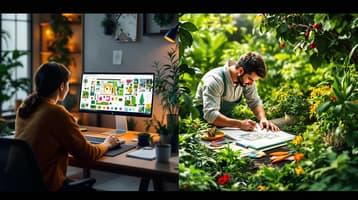
Digital vs Traditional Garden Design: Pros and Cons
Explore the advantages and challenges of digital and manual garden design methods to find the best approach for your project.
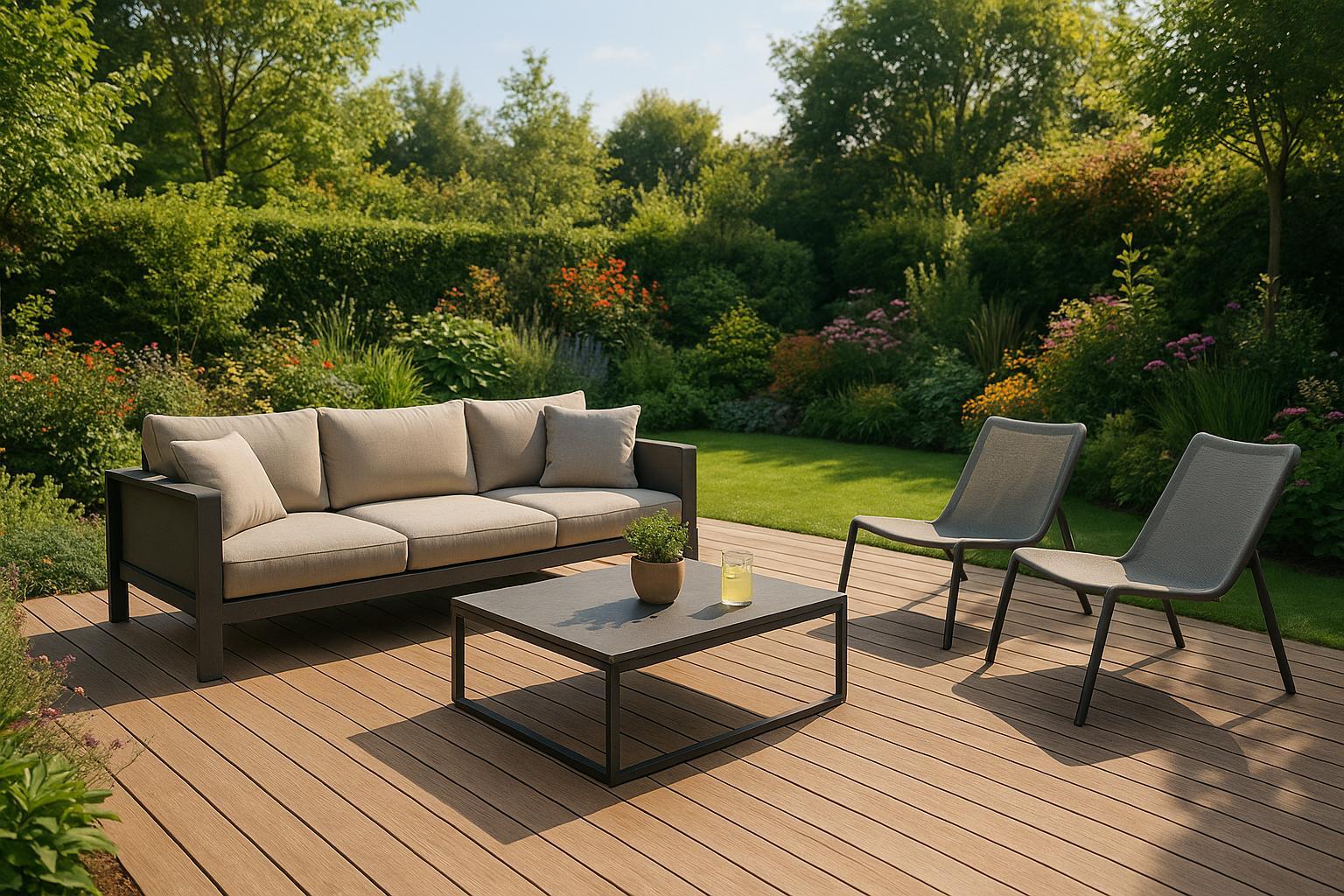
AI-Driven Garden Furniture Placement: How It Works
Transform your garden with AI-driven furniture placement that optimizes style, comfort, and functionality based on your space and preferences.

Effective Ways to Deter Chickens from Your Garden
Discover strategies to keep chickens out of your garden and protect your plants. Learn about physical barriers, natural deterrents, and scare tactics for effective chicken deterrence.
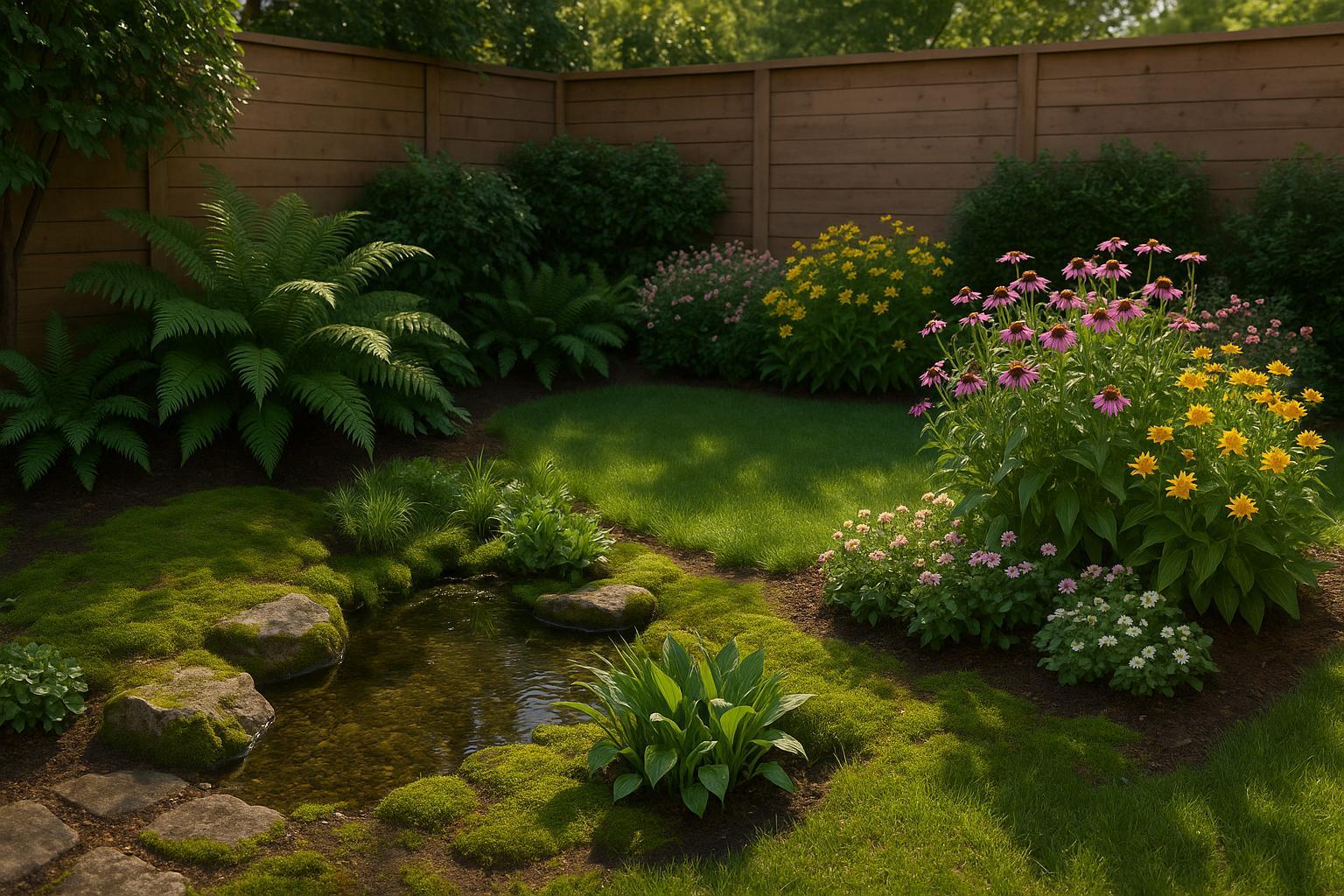
How Microclimates Affect Plant Placement Decisions
Learn how microclimates influence plant growth and discover effective strategies for optimal plant placement in your garden.
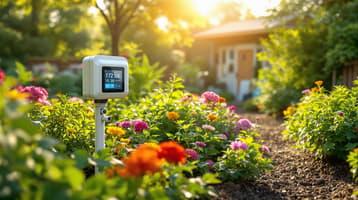
How AI Predicts Garden Maintenance Needs
Explore how AI enhances garden maintenance by optimizing watering, fertilizing, and pruning schedules for healthier plants and efficient resource use.
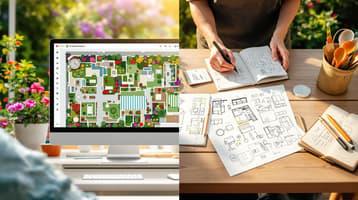
AI Garden Planners vs. Traditional Methods
Explore the differences between AI garden planners and traditional methods, highlighting their strengths, limitations, and how they can complement each other.